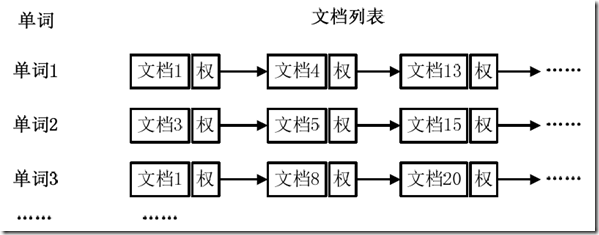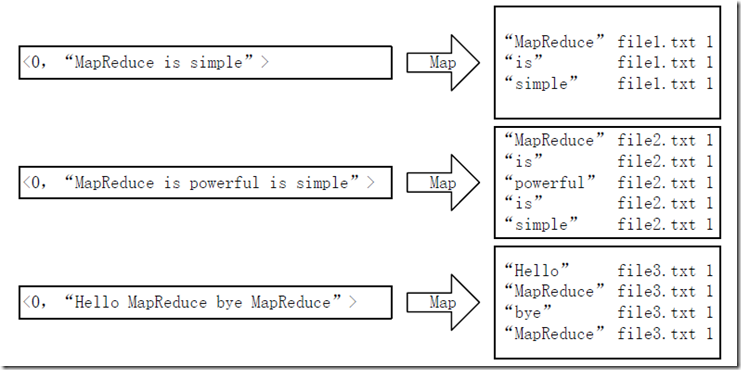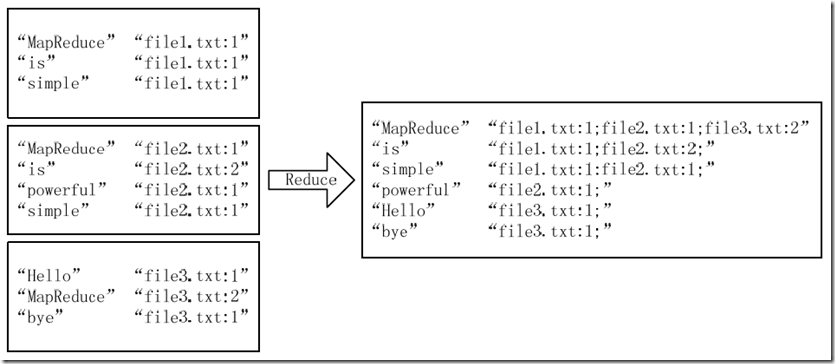“倒排索引”是文档检索系统中最常用的数据结构,被广泛地应用于全文搜索引擎。它主要是用来存储某个单词(或词组)在一个文档或一组文档中的存储位置的映射,即提供了一种根据内容来查找文档的方式。由于不是根据文档来确定文档所包含的内容,而是进行相反的操作,因而称为倒排索引(Inverted Index)。
1、说明
通常情况下,倒排索引由一个单词(或词组)以及相关的文档列表组成,文档列表中的文档或者是标识文档的ID号,或者是指文档所在位置的URL,如图1-1所示。

图1-1 倒排索引结构
从图1-1可以看出,单词1出现在{文档1,文档4,文档13,……}中,单词2出现在{文档3,文档5,文档15,……}中,而单词3出现在{文档1,文档8,文档20,……}中。在实际应用中,还需要给每个文档添加一个权值,用来指出每个文档与搜索内容的相关度,如图1-2所示。

图1-2 添加权重的倒排索引
最常用的是使用词频作为权重, 即记录单词在文档中出现的次数。以英文为例,如图1-3所示,索引文件中的”MapReduce”一行表示:”MapReduce”这个单词在文本 T0中出现过1次,T1中出现过1次,T2中出现过2次。当搜索条件为”MapReduce”、”is”、”Simple”时,对应的集合为: {T0,T1,T2}∩{T0,T1}∩{T0,T1}={T0,T1},即文档T0和T1包含了所要索引的单词,而且只有T0是连续的。

图1-3 倒排索引示例
更复杂的权重还可能要记录单词在多少个文档中出现过,以实现TF-IDF(Term Frequency-Inverse Document Frequency)算法,或者考虑单词在文档中的位置信息(单词是否出现在标题中,反映了单词在文档中的重要性)等。
样例输入如下所示。
1)file1:
MapReduce is simple2)file2:
MapReduce is powerful is simple3)file3:
Hello MapReduce bye MapReduce样例输出如下所示。
MapReduce file1.txt:1;file2.txt:1;file3.txt:2;
is file1.txt:1;file2.txt:2;
simple file1.txt:1;file2.txt:1;
powerful file2.txt:1;
Hello file3.txt:1;
bye file3.txt:1;2 设计思路
实现”倒排索引”只要关注的信息为:单词、文档URL及词频,下面根据MapReduce的处理过程给出倒排索引的设计思路。
1)Map过程
首先使用默认的TextInputFormat类对输入文件进行处理,得到文本中每行的偏移量及其内容。显然,Map过程首先必须分析输入的<key,value>对,得到倒排索引中需要的三个信息:单词、文档URL和词频,如图2-1所示。

图2-1 Map过程输入/输出
这里存在两个问题:第一,<key,value>对只能有两个值,在不使用Hadoop自定义数据类型的情况下,需要根据情况将其中两个值合并成一个值,作为key或value值;第二,通过一个Reduce过程无法同时完成词频统计和生成文档列表,所以必须增加一个Combine过程完成词频统计。
这里讲单词和URL组成key值(如”MapReduce:file1.txt”),将词频作为value,这样做的好处是可以利用MapReduce框架自带的Map端排序,将同一文档的相同单词的词频组成列表,传递给Combine过程,实现类似于WordCount的功能。
2)Combine过程
经过map方法处理后,Combine过程将key值相同的value值累加,得到一个单词在文档在文档中的词频,如图2-2所示。如果直接将图2-2所示的输出作为Reduce过程的输入,在Shuffle过程时将面临一个问题:所有具有相同单词的记录(由单词、URL和词频组成)应该交由同一个Reducer处理,但当前的key值无法保证这一点,所以必须修改key值和value值。这次将单词作为key值,URL和词频组成value值(如”file1.txt:1”)。这样做的好处是可以利用MapReduce框架默认的HashPartitioner类完成Shuffle过程,将相同单词的所有记录发送给同一个Reducer进行处理。

图2-2 Combine过程输入/输出
3)Reduce过程
经过上述两个过程后,Reduce过程只需将相同key值的value值组合成倒排索引文件所需的格式即可,剩下的事情就可以直接交给MapReduce框架进行处理了。如图2-3所示。索引文件的内容除分隔符外与图1-3解释相同。
4)需要解决的问题
本实例设计的倒排索引在文件数目上没有限制,但是单词文件不宜过大(具体值与默认HDFS块大小及相关配置有关),要保证每个文件对应一个split。否则,由于Reduce过程没有进一步统计词频,最终结果可能会出现词频未统计完全的单词。可以通过重写InputFormat类将每个文件为一个split,避免上述情况。或者执行两次MapReduce,第一次MapReduce用于统计词频,第二次MapReduce用于生成倒排索引。除此之外,还可以利用复合键值对等实现包含更多信息的倒排索引。

图2-3 Reduce过程输入/输出
3.Mappper程序:
package cn.edu.bjut.reverseindex;
import java.io.IOException;
import java.util.StringTokenizer;
import org.apache.hadoop.io.LongWritable;
import org.apache.hadoop.io.Text;
import org.apache.hadoop.mapreduce.Mapper;
import org.apache.hadoop.mapreduce.lib.input.FileSplit;
public class ReverseIndexMapper extends
Mapper<LongWritable, Text, Text, Text> {
private String fileName;
@Override
protected void map(LongWritable key, Text value, Context context)
throws IOException, InterruptedException {
String line = value.toString().trim();
if(0 != line.length()) {
StringTokenizer stringTokenizer = new StringTokenizer(line);
while(stringTokenizer.hasMoreTokens()) {
context.write(new Text(stringTokenizer.nextToken()+":"+fileName), new Text("1"));
}
}
}
@Override
protected void setup(Context context)
throws IOException, InterruptedException {
FileSplit fileSplit = (FileSplit) context.getInputSplit();
String path = fileSplit.getPath().toString();
fileName = path.substring(path.indexOf("file"));
}
}
4.Combiner程序:
package cn.edu.bjut.reverseindex;
import java.io.IOException;
import org.apache.hadoop.io.Text;
import org.apache.hadoop.mapreduce.Reducer;
public class ReverseIndexCombiner extends
Reducer<Text, Text, Text, Text> {
@Override
protected void reduce(Text key, Iterable<Text> values, Context context)
throws IOException, InterruptedException {
int num = 0;
for(Text text : values) {
num += Integer.parseInt(text.toString());
}
String[] arr = key.toString().split(":");
context.write(new Text(arr[0]), new Text(arr[1]+":"+num));
}
}
5.Reducer程序:
package cn.edu.bjut.reverseindex;
import java.io.IOException;
import org.apache.hadoop.io.Text;
import org.apache.hadoop.mapreduce.Reducer;
public class ReverseIndexReducer extends
Reducer<Text, Text, Text, Text> {
@Override
protected void reduce(Text key, Iterable<Text> values, Context context)
throws IOException, InterruptedException {
StringBuffer stringBuffer = new StringBuffer();
for(Text text : values) {
stringBuffer.append(text.toString()+";");
}
context.write(key, new Text(stringBuffer.toString()));
}
}
6.主程序:
package cn.edu.bjut.reverseindex;
import org.apache.hadoop.conf.Configuration;
import org.apache.hadoop.fs.FileSystem;
import org.apache.hadoop.fs.Path;
import org.apache.hadoop.io.Text;
import org.apache.hadoop.mapreduce.Job;
import org.apache.hadoop.mapreduce.lib.input.FileInputFormat;
import org.apache.hadoop.mapreduce.lib.output.FileOutputFormat;
public class MainJob {
public static void main(String[] args) throws Exception {
Configuration conf = new Configuration();
Job job = new Job(conf, "ReverseIndex");
job.setJarByClass(MainJob.class);
job.setMapperClass(ReverseIndexMapper.class);
job.setMapOutputKeyClass(Text.class);
job.setMapOutputValueClass(Text.class);
job.setCombinerClass(ReverseIndexCombiner.class);
job.setReducerClass(ReverseIndexReducer.class);
job.setOutputKeyClass(Text.class);
job.setOutputValueClass(Text.class);
FileInputFormat.addInputPath(job, new Path(args[0]));
Path outPath = new Path(args[1]);
FileSystem fs = FileSystem.get(conf);
if(fs.exists(outPath)) {
fs.delete(outPath, true);
}
FileOutputFormat.setOutputPath(job, outPath);
job.waitForCompletion(true);
}
}























 982
982

 被折叠的 条评论
为什么被折叠?
被折叠的 条评论
为什么被折叠?








